How to plant and grow flax in the country?
The cultivation of flax as a cultivated plant began in ancient times. Even the Egyptians wrapped the mummies of the pharaohs in linen. Yarn from this plant is a durable and useful natural material. Over time, bright and picky flax inflorescences have conquered connoisseurs of decorative floriculture.
Description and types
Flax is a herbaceous one- or perennial from the Flax family with linear or narrow-lanceolate leaves and five-dimensional flowers, from 0.5 m to 1.5 m in height.The average length of the stem covered with a waxy bloom is about 50 cm, the leaves are 5 cm. Flowers appear in June-July. Their color is mostly blue, but there are pink and white varieties. After flowering, a fruit-box with ten oily seeds is tied. Each of them is located in a separate slot.
There are over 100 types of flax. As a result of selection, new varieties appear that are endowed with the best qualities of "parents".
- Flax ordinary (spinning) - the only type that is used for the production of linen fabrics. The plant up to 150 cm in height has two main varieties - fiber and curly. Dolgunets is mainly used for making yarn. It is taller, and the inflorescences branch little. Curl is mainly used as a seed plant. It is shorter, but has a more spreading inflorescence.
- Flax large-flowered red - an annual up to 60 cm high, popular in decorative floriculture. Blooms from June to frost. It can be used for cutting into bouquets. It goes well with cornflowers and bells.
- Flax blue - a long-term representative of the family who feels great in one place for up to 5 years. Sun-loving and frost-resistant plant.
- Flax yellow - a relatively drought-resistant perennial. It is a great backdrop for other single plants. Blooms in the first half of summer.
- Oil flax has a more developed root system than other species. At the beginning of growth, it easily tolerates a lack of water, however, from the beginning of budding to the formation of bolls, the need for moisture increases. It is the richest source of omega-3 fatty acids.
The growing season of a plant depends on the type of flax and ranges from 80 to 110 days.
Reproduction methods
Young flax plants can be obtained by sowing seeds, grafting or dividing an adult bush.
- In summer, perennial flax can be grafted. Young shoots about 15 cm long are broken out near the base of the main shoot. They are rooted in loose soil, protected from direct sunlight and watered regularly. The next year, young plants are planted.
- The division of the bush is used to propagate perennial flax species. Work is carried out in April, at the beginning of active growth, or in August, after flowering. A healthy large bush older than two years is divided into several parts. The resulting cuttings are immediately planted at a distance of about 0.2 m from each other. At first, young plants are protected from direct sunlight and are often watered.
- The seed method is a simple and quick option for producing many beautiful flowers at once. Flax is most often propagated by seed.
How to plant flax?
Seeds can be sown in open ground or pre-grown seedlings in room conditions. The choice of option depends on the capabilities of the gardener, the type of plant and the growing area.
In regions with a relatively mild and warm climate, sowing is carried out in open ground. A plot for plants is prepared in advance. Compost or humus is introduced in the fall. Deep plowing or digging is carried out. In the spring, the site is harrowed and leveled.Flax is sown in April-May, when the soil warms up to +7 degrees at a depth of about 10 cm, and the daytime temperature rises to +20 degrees. In this case, seedlings are more friendly and flax is less sick. If during this period the temperature drops, then the plants germinate even at +2 degrees. The seeds are distributed evenly, to a depth of about 1 cm. Then the plantings are moistened with a sprinkler. Amicable shoots appear in a couple of weeks. When they grow to 4-5 cm, they are thinned out. The distance between adjacent specimens should be about 15-20 cm.
For early flowering next year, you can carry out subwinter sowing in open soil. The autumn seeding season is suitable for areas with a warm climate. In this case, the work is performed before the onset of cold weather, with an average daytime air temperature of at least +20 degrees. Sowing in rainy and damp weather is not recommended. Young plantings must be covered with dry leaves or other material before frost.
At home, perennial varieties can be propagated by seeds, which are pre-sown in containers. This will allow you to get flowering plants earlier.
Some types of flax do not tolerate transplanting in open ground, get sick and may even die. Therefore, before buying seeds, check the features of a particular plant variety.
As soon as it gets warmer, the flax in the containers is gradually accustomed to fresh air. At daytime temperatures above +20 degrees, prepared specimens are transplanted into the ground on the site.
It is possible to achieve high germination of flax seeds if at the initial stage of growth the plants receive enough water.
Care secrets
Flax can be planted in the country, in the yard or grown in the field as an industrial crop. If you follow simple rules, the plant will retain its health and beauty longer.
- Choosing a place.
In regions with few sunny days, it is problematic to grow flax. For him, they choose areas protected from strong winds.
- Temperature conditions.
The optimum temperature during active growth and flowering of flax is up to +17 degrees. Dry and warm weather is needed during seed ripening.
- Priming.
To grow flax, you need a site with deep groundwater and breathable loose soil. Wet loamy soil with medium density is most suitable; it grows worse on sandy flax. Heavy clay as well as acidic soils are not suitable for this plant.
- Watering.
Periodic moistening is carried out, preventing soil stagnation in the area with flowers. In warm and dry weather, watering is carried out 1-2 times a week; by autumn, the frequency of humidification is gradually reduced. Do not water during the rains during the growing season and in winter.
To maintain decorativeness on the plant, wilted flowers are systematically removed. Weeds are removed in time, plantings are weeded in time.
During the period of active growth, during the formation of buds, fertilizing is carried out with a complex mineral fertilizer. Excess nitrogen at the beginning of flax growth can lead to delayed flowering, aging and rust development.
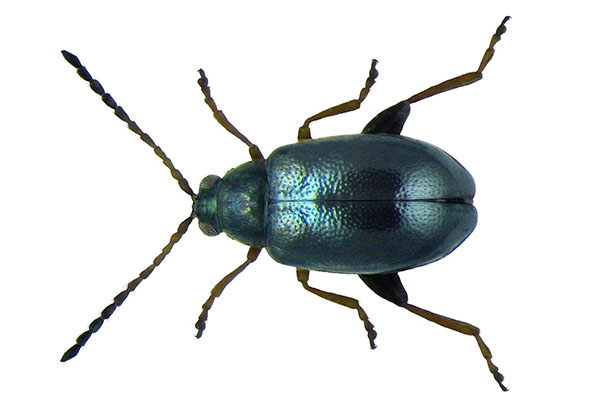
Pests and diseases
Flax is quite resistant to various diseases and pests, but sometimes it still suffers from them, especially with a decrease in immunity due to unfavorable growing conditions.
- The plant can be affected by the linseed flea. In early spring, pests of this species feed on weeds, then migrate to flax. Insect larvae feed on roots. Black-green, brown or bluish beetles, about 2 mm long, eat away part of the leaves and capsules with seeds. In large quantities, they can damage the growth point, which causes the death of the plant.
- Linseed moth caterpillars destroy buds, flowers and seed boxes.
- Dark brown flaxseed thrips and their larvae suck up the sap of plants and cause its pathological branching.Damaged flax specimens lag behind in growth, leaves curl on them and buds fall off.
Folk methods of pest control are ineffective. They are treated with insecticides during the period of mass colonization of crops by pests.
Flax can be affected by various fungal infections. The source of diseases is the remains of damaged plants, contaminated soil, contaminated seeds.
- In case of fusarium disease, the tops of the plant first droop, the stems and leaves turn yellow. Later, the foliage curls, the stems darken, the flower dies.
- Rust causes yellowish-brown spots on the leaves in the spring, followed by rash-like rusty-orange lesions during budding and flowering. At the end of the growing season, glossy black scabs are visible on the stems, capsules and stalks.
- Anthracnose causes a marble spot on the stems, more often at the base. The leaves are covered with blurry brown spots. The disease develops rapidly in high humidity.
Fusarium and anthracnose remain viable for 5-6 years, so it is better to re-plant flax in one area after this period. Liming will help reduce the rate of development of fungal diseases. Lime is applied on acidic soils in advance, 2 years before growing this plant on them. A 1% colloidal sulfur solution will help get rid of rust and powdery mildew.
Common flax gives useful seeds and fibers, and decorative varieties of this plant bloom well with minimal care. This plant looks spectacular on a flower bed and pleasantly surprises with its unpretentiousness and bright appearance.
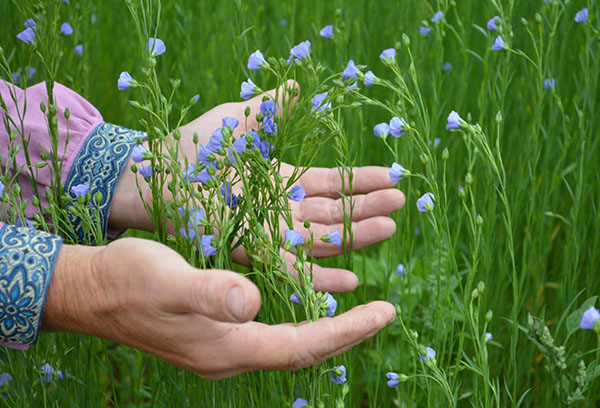
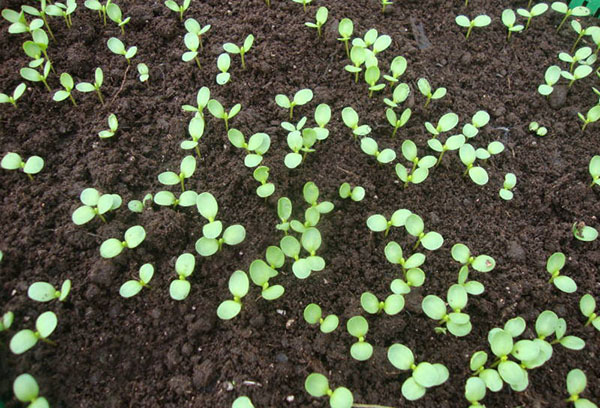
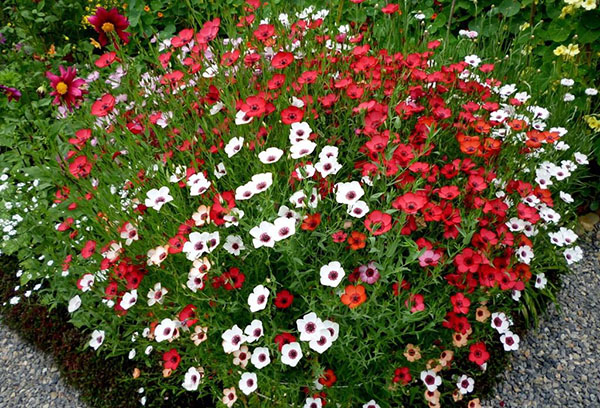
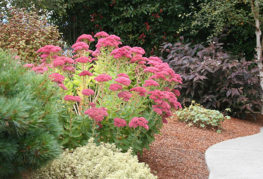

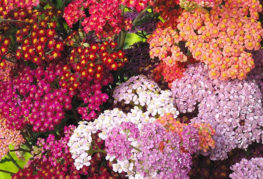
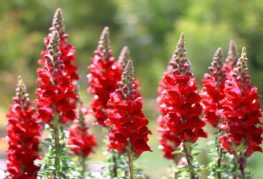

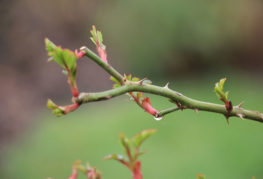
and will be published shortly.